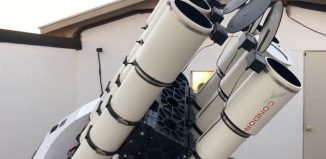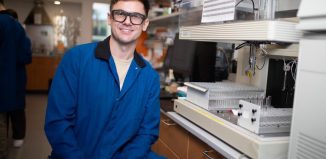BNL’s Venugalapan blazes his own subatomic trail
When he was 15, Raju Venugalapan spent what was then a considerable sum of money to buy three books on what his parents thought was an obscure subject. Living in India, where he was born and raised, Venugalapan bought the Feynman lectures, books that were based on lectures delivered to students at the California Institute of Technology by Nobel laureate Richard Feynman. These lectures were designed to make physics more vibrant and inspirational.
The books worked for Venugalapan, who was determined to enter the field of physics. The would-be physicist, however, had a problem — his parents weren’t sure this represented a viable career choice. For them, studying physics was like writing poetry, he said. While it might have value, it could be difficult to earn a living and support a family.
His parents’ opinion changed, however, when he received a full scholarship to study physics at the University of Chicago.
Over a quarter of a century later, Venugalapan is a senior scientist and group leader of the Nuclear Theory Group in the Physics Department at Brookhaven National Laboratory.
“I love getting up in the morning and going to work,” said Venugalapan. His daily pursuits are something that are “very natural to me, like breathing.” What makes his work so exciting, Venugalapan said, is that he can address questions about some of the unknown structural elements of matter.
“I see various data as pieces of a jigsaw puzzle that, together with theoretical insight, can provide a larger picture of the sub-nuclear scale matter,” he explained.
Larry McLarren, a senior scientist and a group leader at the Riken BNL Center, said Venugalapan’s approach and theories have proven successful.
“He’s developed many of the ideas that are hot right now,” he said. Venugalapan is “somebody who has done a lot of good work and is full of energy.”
Venugalapan studies data that comes out of the Relativistic Heavy Ion Collider at BNL, where scientists collide protons and neutrons almost to the speed of light. The heat generated from these collisions is 100,000 times hotter than the center of the sun, although they last for an unimaginably small amount of time.
Feynman — the physicist who inspired Venugalapan — described this process as being similar to smashing two Swiss watches together. At this point, he said, “we don’t have the luxury of taking apart” subatomic particles such as gluons and quarks.
A few years ago, he and his colleagues had developed a theory about the correlations of gluons and how they would behave. One of the team members made a prediction for proton-proton collisions at the Large Hadron Collider near Geneva, Switzerland.
Because the signal was too small, the group published its result as a curiosity in a conference proceeding rather than in a scientific journal. When the LHC experimentalists found this phenomenon, Venugalapan and his team were able to put out a paper within a week of the announcement.
The event they described was about a one in a million occurrence in a proton-proton collision. “It was extremely exciting,” he recalled. “It was the biggest high you can imagine.”
After the original result, the science progressed as it often does in the face of new information and a new theory: Other researchers performed similar experiments to confirm the data — and to test the idea behind it.
“I’d go to bed at night with a mixture of anticipation and trepidation,” Venugalapan said. There might be a new paper out that “either killed or confirmed our idea.”
Venugalapan and his colleagues believed there could be two phenomena that could cause the effect: One was hydrodynamics and the other was a so-called quantum synchronicity of gluons.
A resident of Riverhead, Venugalapan enjoys sailing with his family on Peconic Bay. As for his work, Venugalapan said he still marvels at how the theories he and his colleagues create might describe events at a subatomic level.
“When you’re making up these mathematical edifices, there’s a certain level of disbelief that this can describe the world,” he said. “We’re playing with paper and equations and, on the other side of the world, there’s a 15-ton detector” that’s running experiments. He wonders: “What do my scribbles have to do with what they see there?”
As for his parents, he said they had a point: “The creative process in science and theoretical physics in particular is not unlike that in poetry.”






